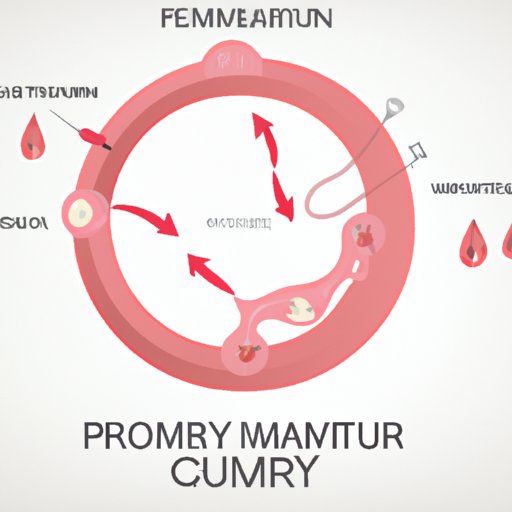Introduction
One in eight couples have difficulty conceiving, making it important to understand when you ovulate to boost your chances of getting pregnant. Knowing when you’re most fertile can also help you avoid unwanted pregnancies. This article covers everything you need to know about ovulation after your period, from understanding your menstrual cycle to charting your cycle and maximizing your fertility.
Understanding Your Menstrual Cycle: A Guide to Ovulating After Your Period
The menstrual cycle is the reproductive cycle that prepares your body for pregnancy. The average menstrual cycle length is approximately 28 days, but it can range from 21 to 35 days. It’s important to understand the phases of your menstrual cycle to identify when you’re most fertile.
There are four phases of the menstrual cycle. The follicular phase occurs when the follicles in your ovaries mature, preparing to release an egg. The ovulatory phase is the shortest phase and occurs when the mature egg is released from the ovaries. The luteal phase follows when your body prepares for pregnancy, and the menstrual phase is when your uterus sheds its lining if fertilization does not occur.
During the ovulatory phase, which typically occurs around day 14 of a 28-day cycle, your ovary releases a mature egg that travels to the fallopian tube awaiting fertilization by sperm, which can live for up to five days in the body.
The Science of Ovulation: How Many Days After Your Period Can You Expect to Ovulate?
Every woman is unique, and her menstrual cycle can vary in length from month to month. While the average length of a menstrual cycle is 28 days, it can range from 21 to 35 days. Therefore, calculating your ovulation day can vary.
The easiest way to determine your ovulation day is to track your menstrual cycle for a few months to identify its length and predict when you’re most fertile. A menstrual cycle calendar or app can be helpful in tracking your cycle and predicting your ovulation days.
Several factors can affect the length of your menstrual cycle and the timing of ovulation, including stress levels, physical activity, diet, weight, age, and hormonal imbalances.
Maximizing Your Fertility: Knowing When You’re Ovulating After Your Period
Tracking your ovulation is essential in maximizing your chances of conceiving. The most natural and affordable method to track your ovulation is by monitoring your basal body temperature, which increases during ovulation. Ovulation prediction kits that test your urine for the luteinizing hormone (LH) can also detect your most fertile days.
Other methods include monitoring changes in cervical mucus, tracking changes in the cervix’s position, and observing symptoms such as breast tenderness and increased sex drive. Knowing your ovulation days can help you time your intercourse and boost your chances of getting pregnant.
You can maximize your fertility during ovulation by maintaining a healthy diet, avoiding alcohol, tobacco, and caffeine, and engaging in moderate exercise. Men should also take steps to improve fertility by wearing loose-fitting pants, avoiding hot tubs, and maintaining a healthy weight.
From Menstruation to Conception: How Long Does It Take to Ovulate After Your Period?
The length of the menstrual cycle varies depending on the individual. It typically takes an egg around 12-24 hours to travel from the ovary to the fallopian tubes after ovulation. However, sperm can live for up to five days inside the female reproductive system.
Therefore, identifying your most fertile days and timing sexual intercourse before ovulation can increase your chances of conception. Additionally, factors such as age, health, and lifestyle can affect the chances of conception.
Charting Your Cycle: A Step-by-Step Guide to Determining Your Ovulation Days After Your Period
Charting your menstrual cycle is an excellent way to track your ovulation days and maximize your chances of conception. To chart your cycle:
- Record the first day of your last menstrual period.
- Track your basal body temperature daily before getting out of bed and recording the readings on a chart.
- Monitor cervical mucus changes and notes that on the chart.
- Use ovulation prediction kits to test for LH and record the results.
- Identify your ovulation days by reviewing the chart, noting the changes in basal body temperature, LH levels, and cervical mucus.
Fertility tracking apps can also aid in charting your cycle by providing reminders and tracking tools to aid in understanding your body’s fertility signals.
Conclusion
Knowing when you ovulate after your period is crucial in maximizing your chances of conception. Understanding your menstrual cycle and tracking it can help you predict your most fertile days and time intercourse correctly. By utilizing the techniques described in this article and seeking ample rest, maintaining a good diet, and avoiding stress, you are on your way to increasing your success rate when trying to conceive.
Resources for further information on fertility and ovulation include fertility clinics, online resources, and OBGYN professionals.
(Note: Is this article not meeting your expectations? Do you have knowledge or insights to share? Unlock new opportunities and expand your reach by joining our authors team. Click Registration to join us and share your expertise with our readers.)
